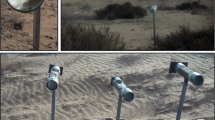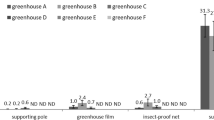Abstract
Dispersal of conidia of Fusicladium eriobotryae, the causal agent of loquat scab, was investigated in two loquat orchards in Spain from 2010 to 2012. A volumetric spore sampler, horizontally and vertically orientated microscope slides, and rain collectors were placed in loquat fields to trap conidia of F. eriobotryae. No conidia were collected in the volumetric sampler, and highly variable numbers of conidia were collected in the rain gatherers. Large numbers of conidia were collected by microscope slides, particularly by those held in a horizontal orientation compared with those held in a vertical orientation. Approximately 90 % of the F. eriobotryae conidia were collected during rainy periods. Based on ROC and Bayesian analysis, using ≥ 0.2 mm rainfall as a cut-off value resulted in a high probability of correctly predicting actual conidial dispersal, and had a low probability of failing to predict actual conidial dispersal. Based on the index of dispersion and the binary power law, the incidence of loquat scab on fruit was highly aggregated in space between and within trees, and aggregation was influenced by disease incidence. Our results demonstrate, for the first time, that F. eriobotryae is dispersed mainly in rain splash. The results will be integrated into a mechanistic, weather-driven, disease prediction model that should help growers to minimize fungicide application for the management of loquat scab.






Similar content being viewed by others
References
Amponsah, N. T., Jones, E. E., Ridgway, H. J., & Jaspers, M. V. (2009). Rainwater dispersal of botryosphaeria conidia from infected grapevines. New Zealand Plant Protection, 62, 228–233.
Bock, C. H., Cottrell, T. E., Hotchkiss, M. W., Wood, B. W., & Road, D. (2013). Vertical distribution of scab in large pecan trees. Plant Disease, 97, 626–634.
Bock, C. H., Hotchkiss, M. W., Okie, W. R., & Wood, B. W. (2011). The distribution of peach scab lesions on the surface of diseased peaches. European Journal of Plant Pathology, 130, 393–402.
Caffi, T., Gilardi, G., Monchiero, M., & Rossi, V. (2013). Production and release of asexual sporangia in Plasmopara viticola. Phytopathology, 103, 64–73.
Campbell, C. L., & Madden, L. V. (1990). Introduction to plant disease epidemiology. New York: Wiley. 532 pp.
Carisse, O., Meloche, C., Boivin, G., & Jobin, T. (2009). Action thresholds for summer fungicide sprays and sequential classification of apple scab incidence. Plant Disease, 93, 490–498.
Carisse, O., Meloche, C., & Turechek, W. W. (2011). Spatial heterogeneity, incidence-incidence and incidence-lesion density relationship of apple scab (Venturia inaequalis) in managed orchards. European Journal of Plant Pathology, 130, 349–365.
Carisse, O., Rolland, D., Talbot, B., & Savary, S. (2006). Heterogeneity of the aerial concentration and deposition of ascospores of Venturia inaequalis within a tree canopy during the rain. European Journal of Plant Pathology, 117, 13–24.
Fitt, B. D. L., McCartney, H. A., & Walklate, P. J. (1989). The role of rain in dispersal of pathogen inoculum. Annual Review of Phytopathology, 27, 241–270.
Frey, C. N., & Keitt, G. W. (1925). Studies of spore dissemination of Venturia inaequalis (Cke.) Wint. in relation to seasonal development of apple scab. Journal of Agricultural Research, 30, 529–540.
Gladieux, P., Caffier, V., Devaux, M., & Le Cam, B. (2010). Host-specific differentiation among populations of Venturia inaequalis causing scab on apple, pyracantha and loquat. Fungal Genetics and Biology, 47, 511–521.
González-Domínguez, E., Rossi, V., Armengol, J., & García-Jiménez, J. (2013). Effect of environmental factors on mycelial growth and conidial germination of Fusicladium eriobotryae, and the infection of loquat leaves. Plant Disease, 97, 1331–1338.
Gottwald, T. R. (1983). Factors affecting spore liberation by Cladosporium carpophilum. Phytopathology, 73, 1500–1505.
Gottwald, T. R. (1985). Influence of temperature, leaf wetness period, leaf age, and spore concentration on infection of pecan leaves by conidia of Cladosporium caryigenum. Phytopathology, 75, 190–194.
Gottwald, T. R., & Bertrand, P. F. (1982). Patterns of diurnal and seasonal airborne spore concentrations of Fusicladium effusum and its impact on a pecan scab epidemic. Phytopathology, 72, 330–335.
GVA, (2012). Butlletí d’Avisos – Diciembre núm. 12/2012. Generalitat Valenciana, Conselleria d’Agricultura, Pesca i Alimentaciò
Hanley, J. A. (2005). Receiver operating characteristic (ROC) curves (Encyclopedia of Biostatistics 2nd ed.). New York: Wiley.
Hartman, J. R., Parisi, L., & Bautrais, P. (1999). Effect of leaf wetness duration, temperature, and conidial inoculum dose on apple scab infections. Plant Disease, 83, 531–534.
Hirst, J. M., & Stedman, J. (1961). The epidemiology of apple scab (Venturia inaequalis (Cke.) Wint.). Annals of Applied Biology, 49, 290–305.
Jackson, S. L., & Bayliss, K. L. (2011). Spore traps need improvement to fulfil plant biosecurity requirements. Plant Pathology, 60, 801–810.
Kiely, T. B. (1948). Preliminary studies on Guignardia citricarpa: the ascigerous stage of Phoma citricarpa and its relation to black spot of citrus. Proceedings of the Linnean Society of New South Wales, 73, 249–292.
Kotzé, J. M. (1981). Epidemiology and control of citrus black spot in South Africa. Plant Disease, 65, 945–950.
Lan, Z., & Scherm, H. (2003). Moisture sources in relation to conidial dissemination and infection by Cladosporium carpophilum within peach canopies. Phytopathology, 93, 1581–1586.
Latham, A. J. (1982). Effect of some weather factors and Fusicladium effusum conidium dispersal on pecan scab occurrence. Phytopathology, 72, 1339–1345.
Lops, F., Frisullo, S., & Rossi, V. (1993). Studies on the spread of the olive scab pathogen, Spilocaea oleagina. EPPO Bulletin, 23, 385–387.
MacHardy, W. E. (1996). Apple Scab: Biology, Epidemiology, and Management. St. Paul: American Phytopathological Society.
Madden, L. V. (1992). Rainfall and the dispersal of fungal spores. Advances in Plant Pathology, 8, 39–79.
Madden, L. V. (2006). Botanical epidemiology: some key advances and its continuing role in disease management. European Journal of Plant Pathology, 115, 3–23.
Madden, L. V., Hughes, G., & Van den Bosch, F. (2007). The study of plant disease epidemics (p. 421). St. Paul: APS Press.
Meredith, D. S. (1973). Significance of spore release and dispersal mechanisms in plant disease epidemiology. Annual Review of Phytopathology, 11, 313–342.
Mills, W. D., & Laplante, A. A. (1951). Diseases and insects in the orchard. Cornell Extension Bulletin, 711.
Obanor, F. O., Walter, M., Jones, E. E., & Jaspers, M. V. (2008). Effect of temperature, relative humidity, leaf wetness and leaf age on Spilocaea oleagina conidium germination on olive leaves. European Journal of Plant Pathology, 120, 211–222.
Obanor, F. O., Walter, M., Jones, E. E., & Jaspers, M. V. (2010). Effects of temperature, inoculum concentration, leaf age, and continuous and interrupted wetness on infection of olive plants by Spilocaea oleagina. Plant Pathology, 60, 190–199.
Ooka, J. J., & Kommnedahl, T. (1977). Wind and rain dispersal of Fusarium moniliforme in corn fields. Phytopathology, 67, 1023–1026.
Owaga, J.M. & English, H. (1991). Diseases of temperate zone. Tree fruit and nut crops. University of California. 461 pp.
Raabe, R., & Gardner, M. W. (1972). Scab of pyracantha, loquat, Toyon and Kageneckia. Phytopathology, 62, 914–916.
Salerno, M., Somma, V., & Rosciglione, B. (1971). Ricerche sull’epidemiologia della ticchiolatura del nespolo del giappone. Technology Agriculture, 23, 947–956.
Sánchez-Torres, P., Hinarejos, R., & Tuset, J. J. (2007). Identification and characterization of Fusicladium eriobotryae: fungal pathogen causing mediterranean loquat scab. Acta Horticulturae, 750, 343–347.
Sánchez-Torres, P., Hinarejos, R., & Tuset, J. J. (2009). Characterization and pathogenicity of Fusicladium eriobotryae, the fungal pathogen responsible for loquat scab. Plant Disease, 93, 1151–1157.
Scherm, H., Savelle, A. T., Boozer, R. T., & Foshee, W. G. (2008). Seasonal dynamics of conidial production potential of Fusicladium carpophilum on twig lesions in southeastern peach orchards. Plant Disease, 92, 47–50.
Schubert, K. S., Ritschel, A. R. & Braun, U. B. (2003). A monograph of Fusicladium s. lat. (Hyphomycetes). Schlechtendalia, 9, 1–132.
Spósito, M. B., Amorim, L., Bassanezi, R. B., Filho, A. B., & Hau, B. (2008). Spatial pattern of black spot incidence within citrus trees related to disease severity and pathogen dispersal. Plant Pathology, 57, 103–108.
Sutton, T. B., Jones, A. L., & Nelson, L. A. (1976). Factors affecting dispersal of conidia of the apple scab fungus. Phytopathology, 66, 1313–1317.
Turechek, W. W., & Wilcox, W. F. (2005). Evaluating predictors of apple scab with receiver operating characteristic curve analysis. Phytopathology, 95, 679–691.
Umemoto, S. (1990). Relationship between leaf wetness period, temperature and infection of Venturia nashicola to Japanese pear leaves. Annals of the Phytopathological Society of Japan, 57, 212–218.
Viruega, J. R., Moral, J., Roca, L. F., Navarro, N., & Trapero, A. (2013). Spilocaea oleagina in olive groves of southern Spain : survival, inoculum production, and dispersal. Plant Disease, 97, 1–33.
Viruega, J. R., Roca, L. F., Moral, J., & Trapero, A. (2011). Factors affecting infection and disease development on olive leaves inoculated with Fusicladium oleagineum. Plant Disease, 95, 1139–1146.
Waggoner, P. E., & Rich, S. (1981). Lesion distribution, multiple infection, and the logistic increase of plant disease. Proceedings of the National Academy of Sciences of USA, 78, 3292–3295.
Yuen, J. E., & Hughes, G. (2002). Bayesian analysis of plant disease prediction. Plant Pathology, 51, 407–412.
Zweig, M. H., & Campbell, G. (1993). Receiver-operating characteristic (ROC) plots: a fundamental evaluation tool in clinical medicine. Clinical Chemistry, 39, 561–577.
Acknowledgments
This work was funded by the Cooperativa Agrícola de Callosa d’En Sarrià (Alicante, Spain). Financial support by the Programa de Apoyo a la Investigación y Desarrollo (PAID-00-12) de la Universidad Politécnica de Valencia for E. González-Domínguez during her 3-month stay at the Università Cattolica del Sacro Cuore (Piacenza, Italy) is gratefully acknowledged. We would like to thank E. Soler, A. Perez and J.J. Giner for their technical assistance.
Author information
Authors and Affiliations
Corresponding author
Rights and permissions
About this article
Cite this article
González-Domínguez, E., Rossi, V., Michereff, S.J. et al. Dispersal of conidia of Fusicladium eriobotryae and spatial patterns of scab in loquat orchards in Spain. Eur J Plant Pathol 139, 849–861 (2014). https://doi.org/10.1007/s10658-014-0439-0
Accepted:
Published:
Issue Date:
DOI: https://doi.org/10.1007/s10658-014-0439-0




